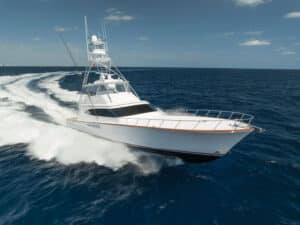
Special delivery: Sign up for the free Marlin email newsletter. Subscribe to Marlin magazine and get a year of highly collectible, keepsake editions – plus access to the digital edition and archives.
It should be no surprise to anyone reading this article that a boat’s engine package is the largest single expense. The power contained within is the heart of the vessel that, if exercised often and maintained properly, will run and perform nearly flawlessly for lifetime of the vessel, or longer. But that’s a big if.
More often than not, most boat owners would place engine maintenance at the bottom of their list of the joys of boat ownership. Maintenance is, however, a vital part of preserving a dependable vessel that will hold its value over time. And when your engines are no longer performing at their peak, it might be time to consider the options: rebuilding the existing engines or repowering with new ones.
Rebuild
Rebuilding can offer many benefits. Not only is it easier and less expensive than a repower, but a complete engine rebuild is often achieved in place, which is a major cost savings when compared with removing the old engines and installing new ones. A refreshed set of engines will regain any lost performance and can help prevent unnecessary maintenance and program downtime—another plus.
A factory rebuild, also known as a major overhaul, consists of a specific set of parts that must be replaced based on the engine’s lifetime totals that are printed in the operation and maintenance manuals. These thresholds are often set by the engine manufacturers based on engine hours, but also by lifetime fuel consumption. Some engine manufacturers even offer extended-warranty options of up to five years when the rebuild is completed by a factory-authorized marine dealer who has authorized access to brand-specific and/or original-equipment-manufacturer’s parts.
Watch: Take a ride on Wall Hanger, a waterjet-powered beauty from Spencer Yachts.
Repower
Repowers have considerable advantages when compared with rebuilds; any time a repower is discussed with your dealer, there are at least two paths to deliberate, and bigger isn’t always better.
The first would be to consider a more efficient, albeit smaller, engine package. A new propulsion-engine package can be designed around optimal efficiency, say, for long-distance fishing and cruising.
Today’s lightweight, power-dense engine technologies, deeper transmission ratios, and modern propeller designs all add up to increased efficiency. A lighter set of engines could also mean better fuel economy, so if your program fancies distant fishing grounds, makes trips up and down the coast, or simply can’t take the gut punch at the fuel dock any longer, then this is the option that should be looked at first.

A recent example of this is a 53-foot custom sportboat whose owner removed its 1,550 hp V-10 engines for a pair of inline sixes rated at 1,150 hp. An obvious decrease in horsepower would have made many owners and captains sick at the thought; however, the decreased weight, coupled with a deeper gear ratio and matching propellers, dramatically increased fuel efficiency and range while losing only a couple of top-end knots.
The second avenue to consider would be to increase the vessel’s cruising speed and top-end performance. New higher-horsepower packages will improve power, acceleration and responsiveness while also increasing the resale value.
Read Next: Learn more about the past, present and future of the Offshore World Championship.
Updated features from engine manufacturers also offer more payback than just an expected increase in horsepower. Improved air- and fuel-system technologies, lighter and more power-dense engine designs, less engine noise, and reduced fuel burn are just a few reasons to consider the repower alternative.
Although a full repower will be more expensive, purchasing new engines could save you money and headaches in the long run with better warranty options. The peace of mind that comes with knowing the power package is fully covered by the manufacturer will be of great comfort to many. So, whether you’re considering a rebuild or a repower, the offseason is the best time for major projects like these. And any engine could see well past its life expectancy if properly maintained, affording you more time on the water and less time spent in the engine room.







